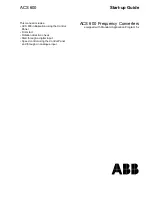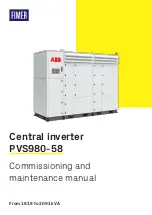
OPERATION
Page
96
2001 Xantrex Technology, Inc.
5916 - 195th Street N. E.
Arlington, WA 98223
Telephone: 360/435-8826
Fax: 360/435-2229
www.traceengineering.com
SW Series Inverter/Charger
Part No. 2031-5
Rev. C: February 2001
240 VAC/60 HZ ONLY ELECTRICAL SYSTEMS
Two 120 VAC / 60 HZ inverters “series” stacked can be used to provide 240 VAC. This provides both 120
and 240 VAC since a center “neutral” is provided between the two inverters. If a 240 VAC only AC source
is connected to the AC input terminals of the inverter without this center neutral, unacceptable operation
will result. To allow connection of a 240 VAC only source to 120 VAC inverter’s, a small (2000 VA) auto-
transformer must be connected across the 240 VAC source with the center of the transformer connected
to the AC neutral terminals of the inverters. This will allow the inverter to operate properly. No transformer
is required on the AC output side - the 240 VAC can be taken directly from the two AC hot output
terminals (one from each inverter).
“PARALLEL” STACKED OPERATION
The parallel stacking interface allows twice the continuous and surge capacity to be available on a single
output circuit from two inverters. The pass-through capacity is also doubled when connected to an AC
source such as a fuel-powered generator or a utility grid. The inverter’s operate in parallel and split the
loads between them. The inverters must be identical models and must have software revision REV 4.01 or
higher software. The inverters must be connected to the same battery bank with equivalent cabling (both
in length and in cable size). The inverter negative terminals of the inverters must be connected together
either at the inverters or at a location close to the inverters (within 18 inches / 0.5 meters).
The parallel stacking interface cable (SWI/PAR) simply plugs into the stacking port on the left end of each
inverter and allows the two inverters to operate as a single inverter. The interface method is based on the
series stacking system offered for the SW Series inverters since their introduction for the North American
market. The parallel stacking system operates the inverters in phase by having one of the inverters
operate as the MASTER and the other as a SLAVE. When an AC source is connected, the MASTER first
synchronizes to the AC source, then connects to it and battery charges. Since the SLAVE follows the
master and is set-up with a longer warm-up delay, the SLAVE inverter is already synchronized when it
transfers the loads and starts battery charging. This allows very smooth transitions from inverter mode to
charger mode.
The parallel stacking interface system allows doubling of the AC pass through capacity. This is useful
when large generators are used. Both inverters will battery charge as allowed by the settings in each of
the inverters.
The hook-up depends upon the other components included in the system and whether it was ordered as
only inverters, a power panel system, or a power module system. With the power module system, the
paralleling enclosure is eliminated and all of the wiring is completed for you. With the individual inverters
and the power panel system, the paralleling enclosure and parallel stacking interface cable must be
installed on site. The paralleling enclosure is connected to each of the inverter’s outputs and is also
connected to the AC loads being powered.
At this time, the paralleled inverters are intended to operate as a single unit. In case of an inverter fault or
error condition, both inverters turn off as one. When the error has been corrected, the inverter will
automatically or manually reset depending upon the type of error condition.
If an inverter failure occurs, the parallel stacking interface can be manually bypassed and the special
parallel stacking interface cable can be removed to allow temporary operation on one unit.
GENERATOR CONTROL SETTINGS
When using two units in parallel, it is recommended that only the SLAVE inverter be used to control the
generator. This is required because the generator control system includes a cool down timer that causes
the controlling inverter to disconnect from the generator before it turns the generator off. If the MASTER
controls the generator, then the SLAVE may not stay in sync with the MASTER during the cool-down
period since it will remain in sync with the generator and not follow the MASTER. There currently is no
adjustment for the cool-down period, so restricting the generator control to the SLAVE is the only solution
available at this time.
The SLAVE also must be set with a longer warm-up period than the MASTER in order to prevent them
from trying to synchronize to the generator at the same time. When the MASTER synchronizes first, the
SLAVE will automatically sync after its warm-up period passes. This also makes the transfer from inverter
to generator smoother and less noticeable.
Summary of Contents for SW Series
Page 151: ......
















































